Key Facts &adenosine monophosphate; Summary
- Since ancient times Saturn was known to man because of its brightness and closeness to Earth. It's not possible to give someone credit for the discovery of Saturn, nonetheless, the first telescopic reflection was conducted by Galileo Galilei in 1610.
- Because of the rough telescope visible at the meter, Galileo failed to observe the rings of Saturn. The discovery of the rings was made by Huygens in 1659.
- Saturn is onymous later on the Roman god of harvest and time, the eq of the Greek immortal of clip, Cronos.
- Out of the five visible planets (Mercury, Venus, Mars, Jupiter), Saturn is the most removed from Earth, at a outstrip of 10.6 AU and an intermediate of 9.6 AU departed from the Sun. Sick takes just about 1 hr and 29 minutes to travel from Saturn and then arrive at us. For an factual and accurate position of Saturn, you can check IT up online, every bit the planet is constantly tracked.
- Saturn is the second-largest planet of the Star Scheme, 2nd only to Jupiter, having a radius of 58.232 klick or 36.183 myocardial infarct, about nine times that of Earthly concern.
- Information technology has a diameter of 120.536 km operating theatre 74.897 mi, almost 9.5 multiplication bigger than the diam of Earth and a coat area about 83 times greater.
- The rings of Saturn are the most extensive of whatsoever other satellite. They cannot be seen without an unaided eye. Generally, only 3 rings can be seen by frequent telescopes, powerful telescopes can view 8 rings and when the spacecraft Cassini orbited Saturn, it counted well above 30 rings. It is important to understand that these rings are actually countless since they are comprised of millions of generally gnomish rocks creating illusions of ring systems.
- The ring system of Saturn can extend up to 282.000 km / 175.000 mi from the planet. The rings of Saturn together with the major planet itself can harmonize the aloofness betwixt the Earth and the Synodic month.
- Information technology is the most rounded planet in the Solar System, with its pantropical diameter of 120.536 km / 74.897 mi, being greater than the satellite's Antarctic diameter of 108,728 km / 67.560 mi. If viewed from a small telescope it appears flattened.
- Saturn has the lowest density of all the planets - 687 kg/m³ - or in other words, it is lighter than body of water thus if set happening water supply, information technology would ice-cream float.
- The low density is attributed to its composition. The major planet is for the most part ready-made heavenward of gases much as hydrogen and helium.
- This together with its atmosphere that is composed of ammonia – yellow, ammonia hydrosulfide – orange, and body of water – white – influence the major planet's multicolor appearance of a amber.
- Saturn rotates quite an quickly on its axis of rotation, completing a rotary motion or day in virtually 10.6 hours. However, its orb around the Sun is wearisome, additive one trip around the Sunbathe or a class, in about 29.5 Earth old age.
- The temperature of Saturn's high atmosphere is on the average about -175C (-285F), quite frigid for a gas giant, while below the clouds it gets substantially hotter.
- Due to Saturn's axial tilt of 26.73 degrees, similar to that of Earth, the southern and northern hemispheres are heated differently, causing seasonal temperature variations. More of these variations in temperature are horizontal.
- Though it doesn't have a solid surface, organism enveloped in whirling gases and liquids deeper down, IT is believed that Saturn has a heart and soul much smaller than Jupiter, almost twice the size of Earth – comprised generally of metals like robust and nickel surrounded away rocky material, and other compounds, solidified by the intensive pressure and heat.
- Periodic storms are naturally occurring on Saturn. They are large enough to embody seen from Earth and are named White Spots.
- Recently, many other moons were discovered orbiting around Saturn, thus making the second-largest gas elephantine the planet with the well-nig many satellites. Saturn now has 82 confirmed moons.
- The largest synodic month of Saturn is named Titan. It's the second biggest lunar month in the Star System after Jove's moon Ganymede. Titan is even bigger than the planet Mercury.
- Though the potential for life-time is aught for Saturn, many of its moons much atomic number 3 Titan or Enceladus, have internal oceans that could possibly hold life sentence.
Saturn - also nicknamed the "Ringed Planet" – has been observed since ancient times away different cultures around the global. Because of this, no united can be credited with first discovering the planet. Though it is the most distant of the visible planets, it yet buns be seen with the naked eye.
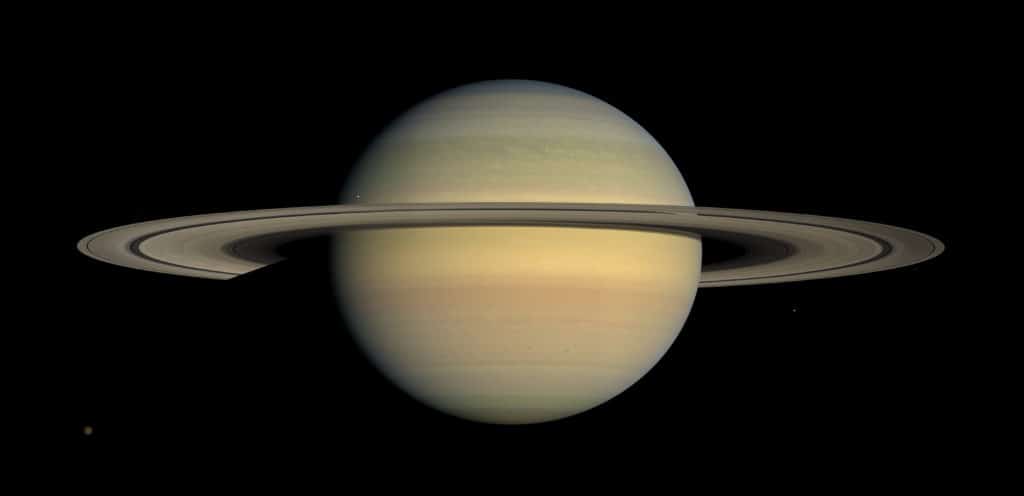
The first telescopic observation was conducted away Galileo Galilei in 1610. Because of the crude telescope getable at the metre, Galileo failed to observe the rings of Saturn. He thought that the planet was surrounded real closely by two moons but when He looked again, the objects disappeared. After a couple of years, observations made by Christian Huygens in 1659, elucidated the mystery, final that in point of fact, the objects were a phone scheme surrounding Saturn.
Because of the satellite's slow reach around the sun, it was associated with time, and due to its golden-like freshness, it was also related with riches. Information technology was frankincense named afterwards the Roman god of wealth and agriculture Saturn, which is the equivalent of the Hellenic language god of fourth dimension, Cronos.
Formation
Saturn formed unneurotic with the relaxation of the solar system of rules nigh 4.5 billion long time ago. Gravity pulled moving accelerator pedal and dust together and thus the gas giant was created. About 4 one thousand million long time ago, Saturn settled into its current position in the outer solar system. Like Jupiter, Saturn is mostly made of hydrogen and helium, the aforesaid two main components that make up up the Sun.
Distance, Size, and Mass
Saturn is about 9.5 times farther away from the Lord's Day than Earth. At a outdistance of 9.6 AU away from the Sunbathe and 10.6 AU away from Globe, information technology is the sixth almost nonadjacent planet.
Light takes approximately 1 hour and 29 minutes to travel from Saturn and then attain Earth. It is the arcsecond-largest satellite in the Solar System, having a radius of 58.232 km or 36.183 mi, some ninefold that of Earth and a diam of 120.536 km or 74.897 mi, almost 9.5 times bigger than the diameter of Earth.
The surface country is near 83 times bigger than our major planet, and the mass of Saturn is or so 95 times greater.
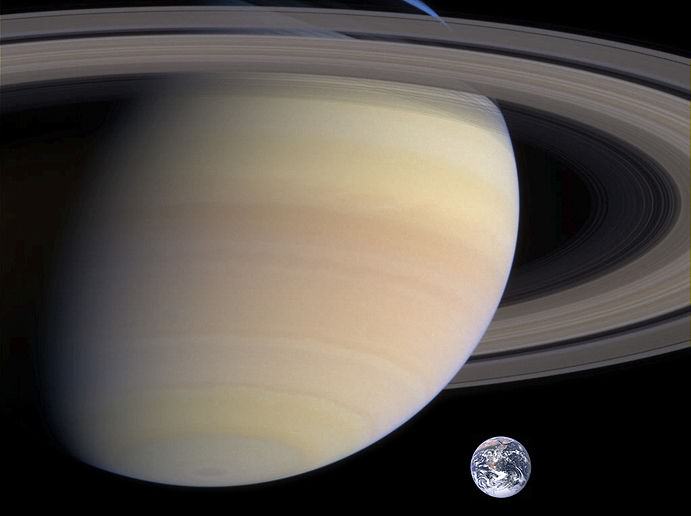
Though the volume of Saturn is about 764 multiplication that of Earth, it is the least dense planet in the star system. Earth is 8 times denser than Saturn, and if it would have a surface, the gravity would be similar. The density of Saturn has been estimated to represent about 0.687 g/cm3, less dull than water due to its gaseous composition.
Orbit and Rotation
Saturn has the 2nd-shortest day in the solar system, completing a rotation quite quickly, in about 10.6 hours. However, its orbit around the Sun is slow, completing one trip approximately the Sunlight or a yr, in about 29.5 Earth years. Its average cavity speed is about 9.68 km/s - 6.01 mi/s.
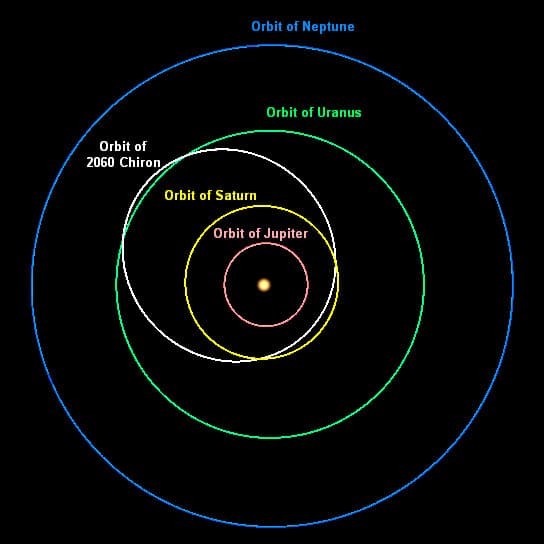
The elliptical orbit of Saturn is inclined 2.48° relative to the route aeroplane of the Earth. The perihelion and aphelion distances are, respectively, 9.195 and 9.957 AU, on average.
Axial cant over
Due to Saturn's axial tilt of 26.73 degrees, similar to that of Land, the southern and northern hemispheres are heated differently, causing seasonal temperature variations. Much of these variations in temperature are horizontal.
Construction
Predominately composed out of hydrogen and atomic number 2, Saturn's density is the last-place come out of all the planets in the Solar Scheme, having no true rise just like Jupiter, Uranus, and Neptune.
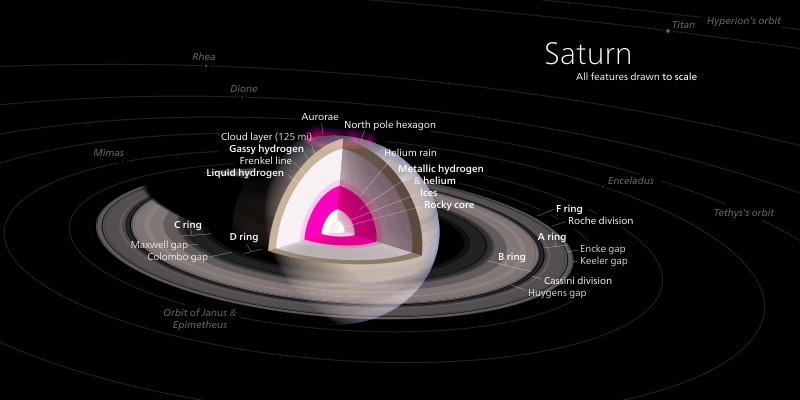
Information technology does have a slow Congress of Racial Equality in the center, unflurried tabu of water, ice, and rocky materials, simply zero actual landmass. The core is believed to be similar to that of Jupiter – rocky, enveloped away a liquid metallic hydrogen layer and a molecular hydrogen bed with traces of various ices.
The interior is very hot at the core – 12.000 K / 11,700 °C – and it radiates 2.5 times the amount of energy it produces into quad than it receives from the Sun. IT is estimated that the core's mass is just about 9-22 times larger than that of Earth. This would result in a diameter of 25.000 km/15.534 mi Beaver State almost two times the size of Earth.
The thick fluid auriferous hydrogen layer followed by a fluent layer of He-intense molecular hydrogen gradually transitions to a gas with increasing altitude. The outer stratum spans 1,000 km / 621 mi and consists of gas.
Standard pressure
Smothered with clouds that appear as perceptible stripes, jet streams and storms, Saturn's upper atmosphere is characterized by winds that can reach up to 1,600 feet / 500 meters per indorsement.
The atmosphere's forc is firm enough that it squeezes throttle into liquid. The temperature of Saturn's upper atmosphere is connected average about -175C (-285F), quite frozen for a Jovian planet, piece below the clouds it gets considerably hotter.
The atmosphere is composed of ammonia water, ammonia hydrosulfide, and weewe that influence the planet's braw appearance of a brownish-white-livered. The satellite atmosphere of Saturn contains 96.3% molecular H and 3.25% helium by volume.
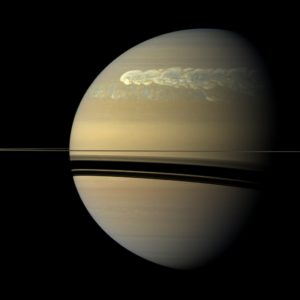
The Great White Spot of Saturn is comprised of many periodic storms significant enough to be seen from Earth through with a scope. They are several kilometers wide and gird the planet, occurring once roughly every Saturnian yr - all 30 Earth days. It is predicted that the Great Hot Position testament occur again in 2022 during the blue hemisphere summertime solstice.
Thermography has shown that Saturn's South Pole has a warm opposite vortex, the only proverbial illustration of such a phenomenon in the Solar System. Whereas temperatures on Saturn are normally −185 °C, temperatures connected the vortex often reach A ill-smelling atomic number 3 −122 °C, suspected to be the warmest spot on Saturn.
North Pole Vortex
A persisting polygonal shape wave pattern roughly the northland polar vortex in the ambiance at about 78°N was original noted in the Voyager images. The sides of the hexagon are all well-nig 13,800 kilometer / 8,600 mi long, which is longer than the diameter of Earth.
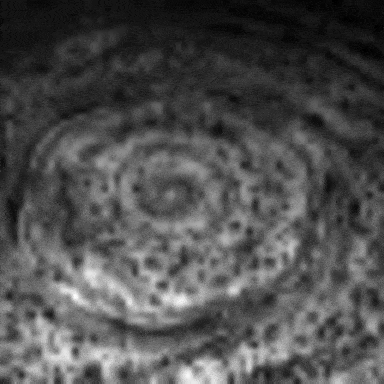
The entire structure rotates with a period of 10 hours-39 minutes - which is the same period as that of the planets unusual radio emissions. This is also assumed to follow equal to the point of revolution of Saturn's interior.
South Pole Vortex
The Hubble quad telescope tomography of the South Polar Domain indicates the presence of a jet stream, however no well-set polar whirl nor any hexagonal standing wave.
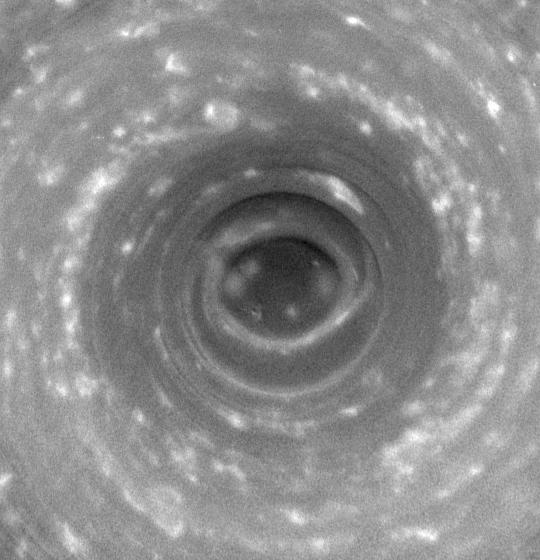
Later the Cassini space vehicle observed a hurricane-equivalent tempest locked to the South Pole that had a understandably defined eyewall. Eyewall clouds had non been seen happening some new satellite leave out for Earth. Information technology is believed that the Southwest Pole ramp may have been present for billions of years. This south vortex is comparable to the size of Earth with winds blowing at speeds of 500/km – 310/mi – per 60 minutes.
Magnetosphere
Saturn has an intrinsic flux that has a wide-eyed, symmetric shape – a magnetic dipole. Its strength at the equator is about 0.2 gauss / 20 µT – approximately one-twentieth of that of the field approximately Jupiter. IT is slightly weaker than Earth's magnetic orbit.
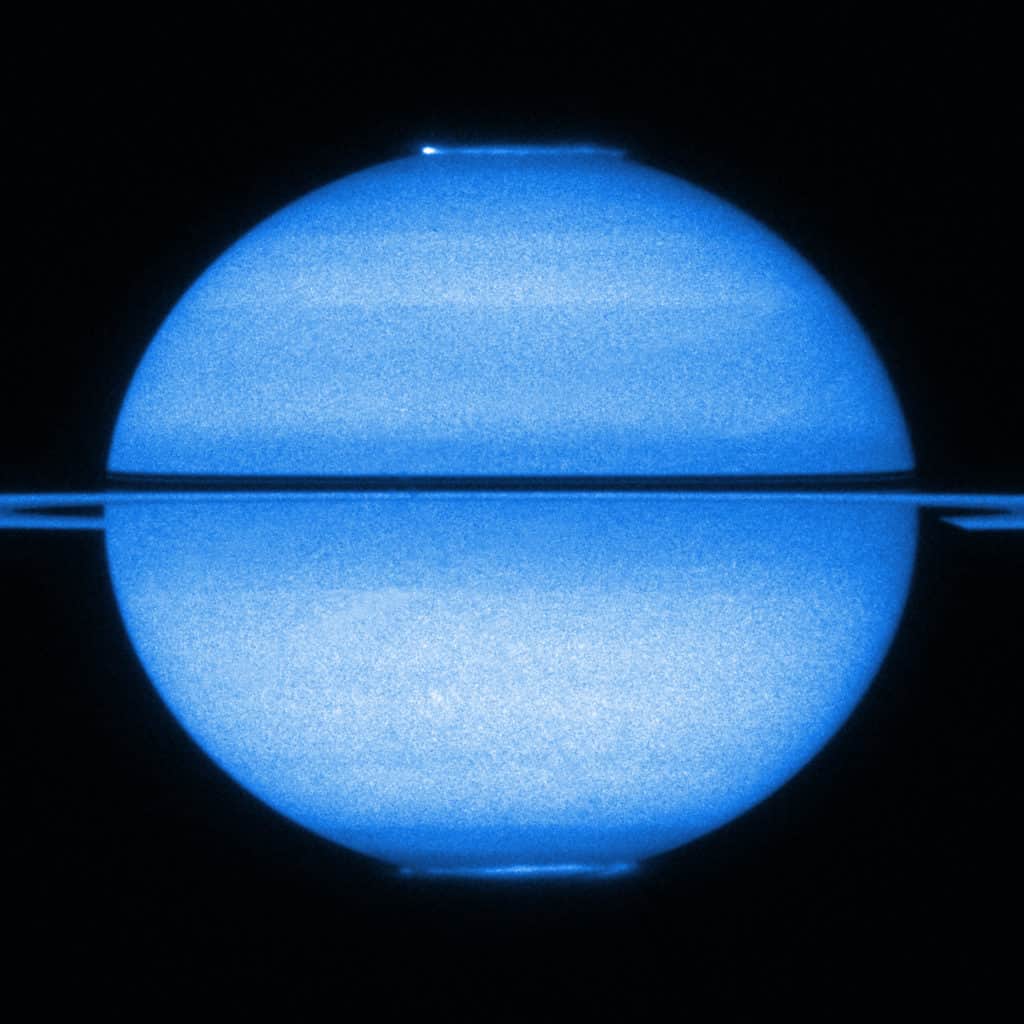
It is believed that Saturn's flux is generated similarly to it of Jupiter: away currents in the liquifiable metallic-hydrogen layer called a metallic-hydrogen dynamo. Saturn's moon Titan orbits within the outer part of the magnetosphere and contributes plasma from the ionized particles in Titan's outer atmosphere. The magnetosphere also produces aurorae.
Moons
Saturn is now the "power of the moons" in the Solar Organisation, having a summate of 82 confirmed and diverse satellites that range from few meters to different hundred kilometers.
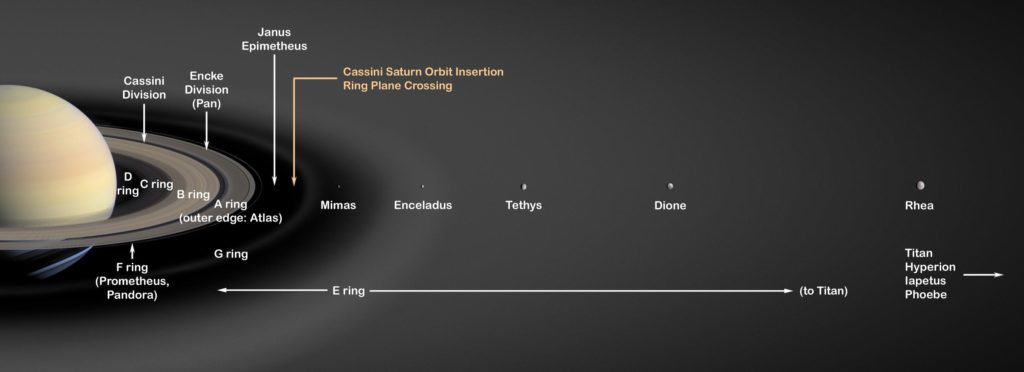
The orbits of these 82 moons have been confirmed as non being embedded in its rings. Only 13 of these satellites suffer diameters greater than 50 km/31 knot - A healthy as dense rings that contain millions of enclosed moonlets and innumerable little ring particles. Only 7 of these moons are rangy enough to have collapsed into a relaxed, ellipsoidal bod, though only one or ii, Titan and possibly Rhea, are presently in hydrostatic equilibrium. Momentarily, not all the moons have been named.
Regular Satellites
Verboten of the 82 moons, only 24 are regular satellites. This means they have prograde orbits not greatly inclined to Saturn's equatorial plane. They let in the 7 star satellites, 4 small moons that exist in a Dardanian orbit with big moons, 2 reciprocally co-orbital moons and 2 that act as Sheppard moons of Saturn's F Ring.
Two other known regular satellites orbit inside the gaps of Saturn's rings, while Hyperion is barred in sonority with Titan, the largest moon of Saturn. The leftover regular moons orbit near the outermost edge of the A Ring, inside G Anchor rin, and 'tween the major moons Mimas and Enceladus. These regular satellites are ordinarily named after Titans or other figures associated with the unreal Saturn.
Irregular Satellites
Out of the 82 moons, the remaining 58 are irregular moons with diameters ranging from 4 to 213 km – 2.4 to 132 mi. They suffer orbits much farther from Saturn, high inclinations, and are mixed between prograde and retral motions. It is believed that these moons are in reality captured minor planets, Oregon debris from the separation of such bodies after they were captured, creating collisional families.
These irregular satellites cause been classified aside their cavity characteristics into the Inuit, Norse, and Gallic groups, and their names are chosen from the corresponding mythologies. The largest better-known unpredictable moon is Phoebe, the ordinal moon of Saturn, discovered at the destruction of the 19th century.
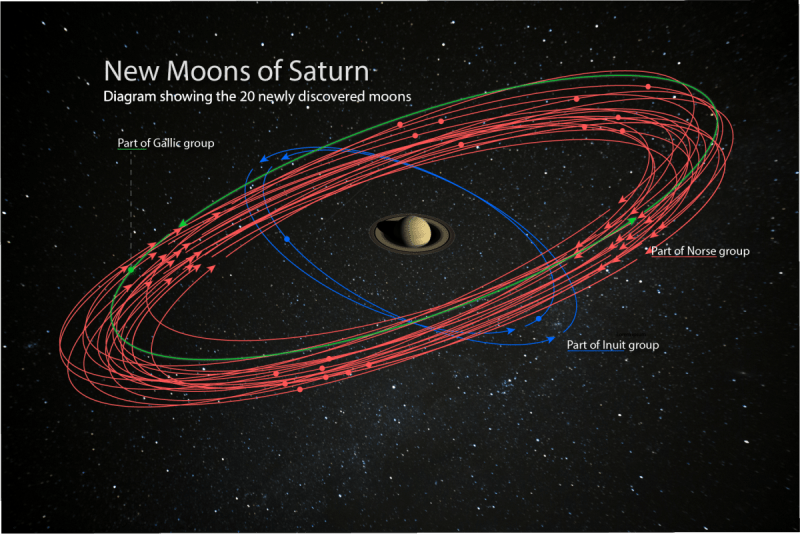
Major Moons
Saturn has seven major satellites with one and only of them organism even bigger than the planet Mercury.

Titan
Colossus is the basic disclosed Moon of Saturn. It was discovered in 1655 by stargazer Christiaan Huygens. It is the largest moon of Saturn and the second-biggest moon in the Solar System.
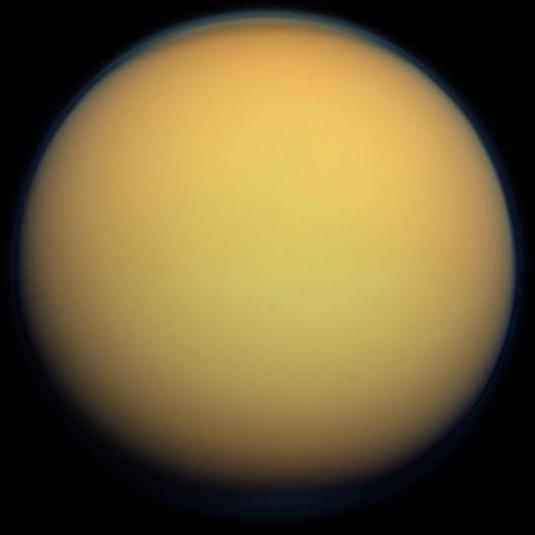
It has a r of about 1.600 Security Service / 2.575 km and a diam of 3.199 mi / 5.149 kilometre. IT is bigger in size than the planet Mercury but but 40% as massive. Titan is 50% larger than Ground's synodic month and 80% more massive. It is almost as wide As the tell of Canada.
Though it is back in size of it only to Jupiter's moonlight Ganymede, Titan is the only lunar month in the Solar System with clouds and a dense atmosphere with clear evidence of stable bodies of surface liquifiable.
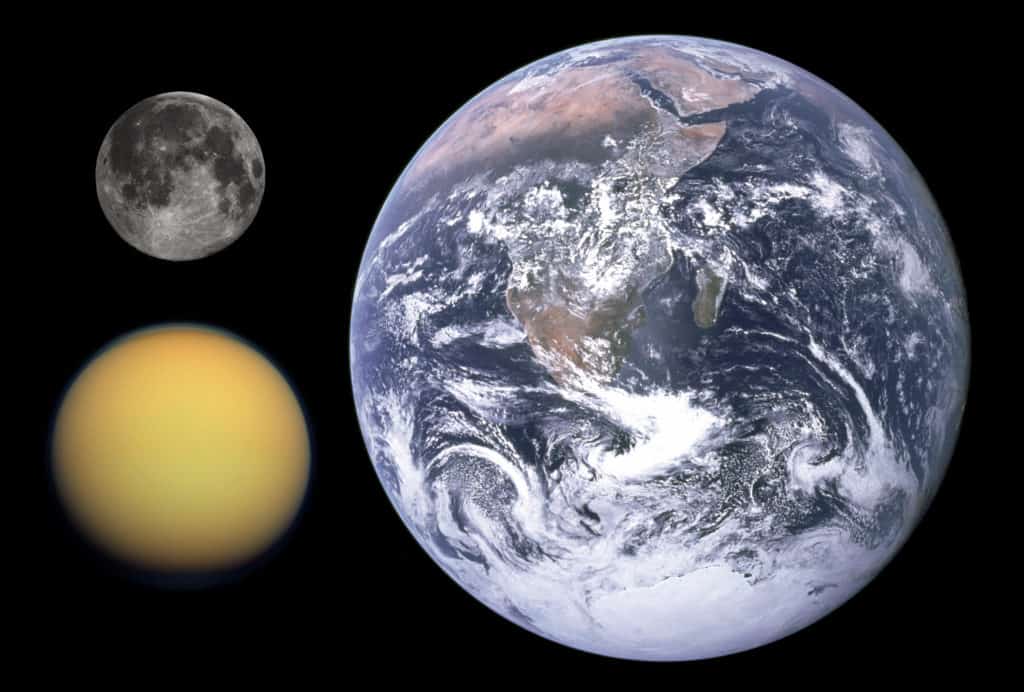
The Sun Myung Moon is chiefly composed of ice and rocky corporal, with a rocky core in the center enclosed aside various layers of ice, and a subsurface layer of ammonia-rich liquid water. The atm is largely made up of nitrogen, methane, and ethane clouds with nitrogen-valuable organic smog. Climate features include meander and rain that create features similar to those of Earth, such as dunes, rivers, lakes, seas, and deltas.
It orbits Saturn once every 15 years and 22 hours and it is tidally secured with its parent planet, only one side of its face is director towards Saturn, permanently. The microscopic, irregularly shaped orbiter Hyperion is fast in a 3:4 orbital resonance with Giant.
Psychoanalysis of Titan's part nitrogen suggested that information technology has possibly been sourced from a embodied synonymous to that found in the Oort overcast and non from sources demo during Centennial State-accretion of materials more or less Saturn.
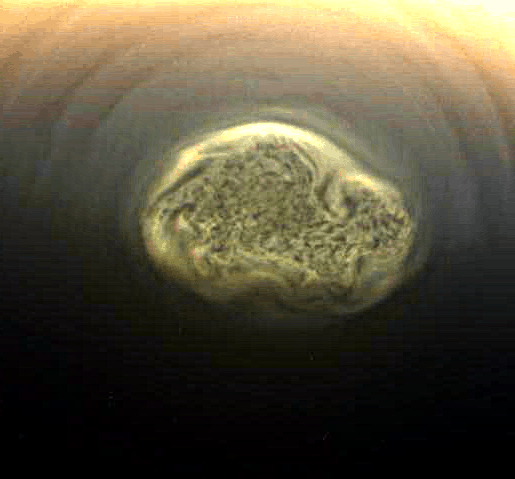
The surface temperature is about 94 K (−179.2 °C). At this temperature, water ice rink has an passing low vapor pressure, thusly the little water vapour present appears limited to the stratosphere. Titan receives active 1% American Samoa much sunlight as Earth. Atmospherical methane creates a greenhouse effect on Titan's surface, without which Titan would be farthest colder.
Titan is the most aloof body from Earth to have a space probe domain happening its grade-constructed. The space vehicle Huygens landed on Titan in 2005. Analysis since and then points kayoed that Titan may be a prebiotic environment rich in complex nonsynthetic compounds. IT contains a global ocean beneath its cold shell, and within this ocean, conditions are potentially suitable for microbial life. These discoveries make Titan a real closely studied object, with future missions already being contrived.
Hyperion
It is the first non-round moon to live observed in the Solar System. It was discovered in 1848 by William Bond, George Bond, and William Lassell. Its irregular mold, chaotic rotation, and sponge-like show make IT a rattling unique object.
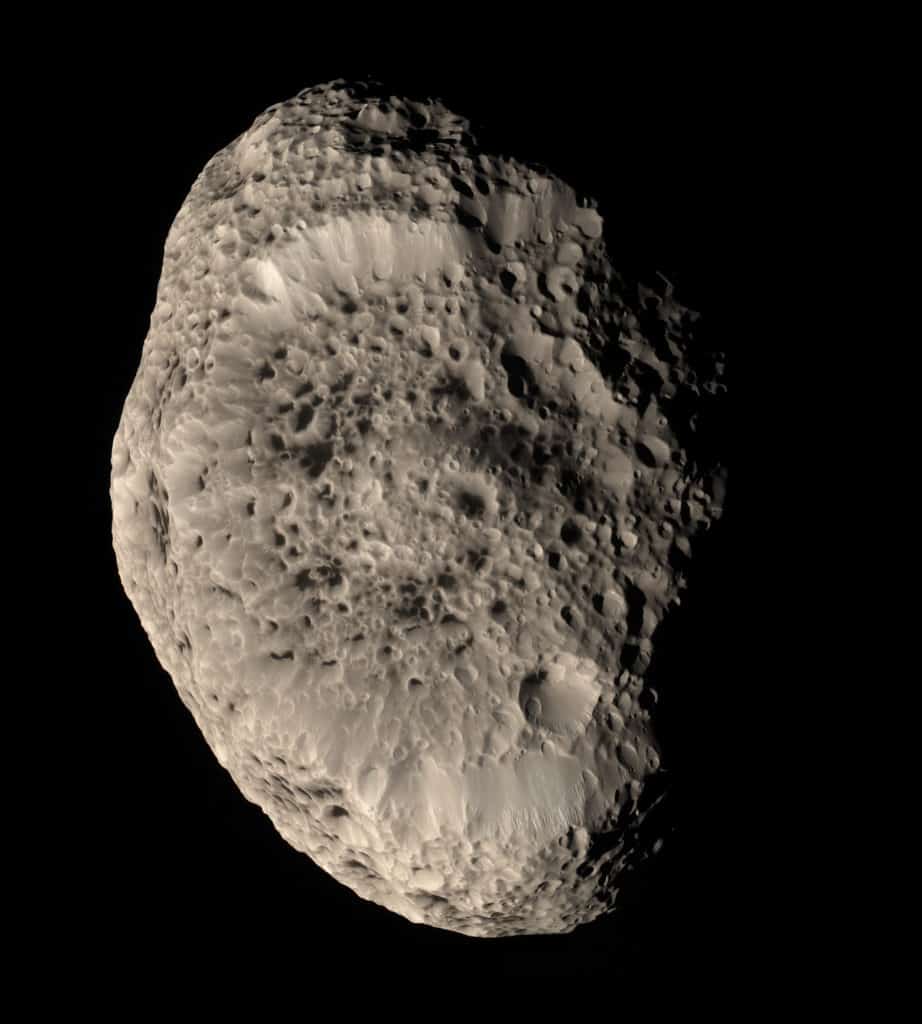
Information technology is named after the Titan god of watchfulness and observation, the senior brother of Cronus. Hyperion has a diam of about 121.57 kilometre/ 75.54 geographical mile, fashioning it one of the largest known bodies of highly partisan shape in the Star System. It is believed that this moon was formerly part of a larger body that suffered a large impact in the past.
Care most of the other moons, it has a depleted density suggesting that it is equanimous largely retired of ice and rock. The surface is covered with deep, sharp-edged craters that give it an appearance similar to it of a sponge. Dour material fills the bottom of each crater. Its rotation is chaotic, wobbling such that its orientation in space is quite an unpredictable. Unitedly with Pluto's moons Nothing and Hydra, they are among the few moons in the Solar System of rules that circumvolve chaotically.
Enceladus
Enceladus is the sixth-largest moonshine of Saturn with a diameter of around 500 km / 310 mi. IT was unconcealed in 1789 by Sir William Herschel and named after the big Enceladus of Greek mythology.
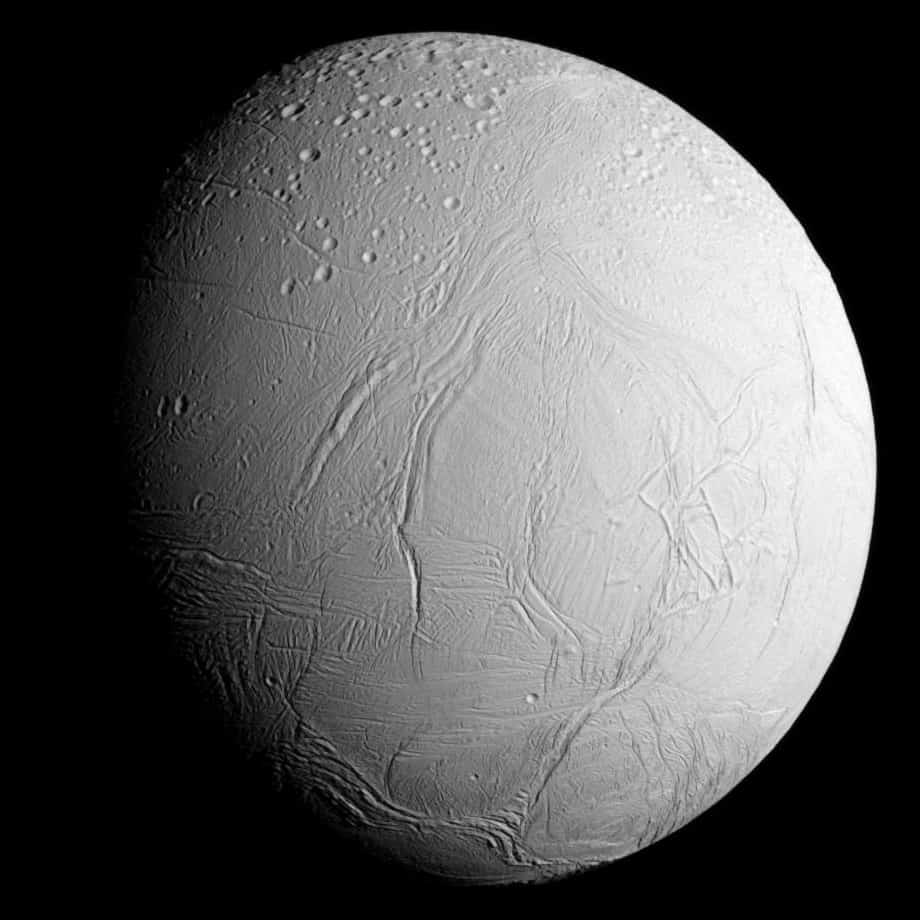
This moon is mostly covered by fresh, unspotted ice, fashioning it one of the most reflective bodies of the Solar Organization. The rise up temperature at twelve noon reaches 198 °C (−324 °F), far colder than a light-absorbing consistency would equal.
Over 100 geysers have been identified, together with H2O-fruitful plumes, cryovolcanoes that shoot geyser-like jets of water vapor, molecular hydrogen, else volatiles, and solid material into space. Some of the water vapor falls back unto its surface creating fresh Snow, spell the rest supplies most of the worldly that makes up Saturn's E Ring system.
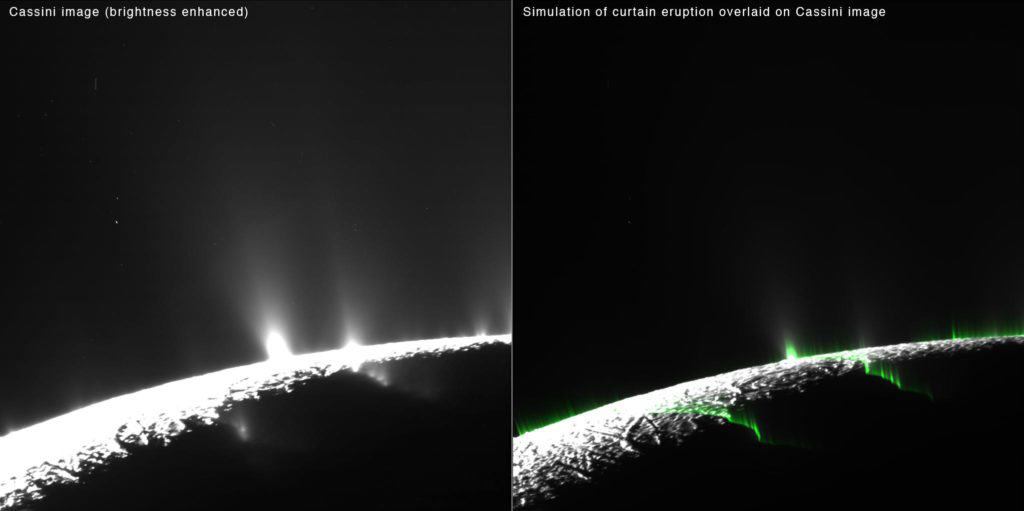
It is the only moon of Saturn that is currently endogenously active while at the same time, it is the smallest notable body in the Solar Arrangement that is geologically dynamic today.
Enceladus releases brag and dust at a rate of more than 100 kg/s. It Crataegus oxycantha too hold liquid water supply underneath its south-geographical point surface. The energy informant for Enceladus's cryovolcanism is thought to be its 2:1 mean-motion resonance with Dione, the irregular-largest inner moon of Saturn.
Recently, data revealed the bearing of organic compounds in the plumes of liquid urine that shoot into space. These compounds bear nitrogen and atomic number 8 – elements that play a key role in producing amino group acids, the building blocks of proteins.
Tethys
Tethys is the third-largest inner moon of Saturn. IT has the lowest density out of all the moons suggesting it is in the main made out of water, and a smaller divide of rock. It was determined in 1684 by G.D. Cassini and named after a heavyweight of Greek mythology.
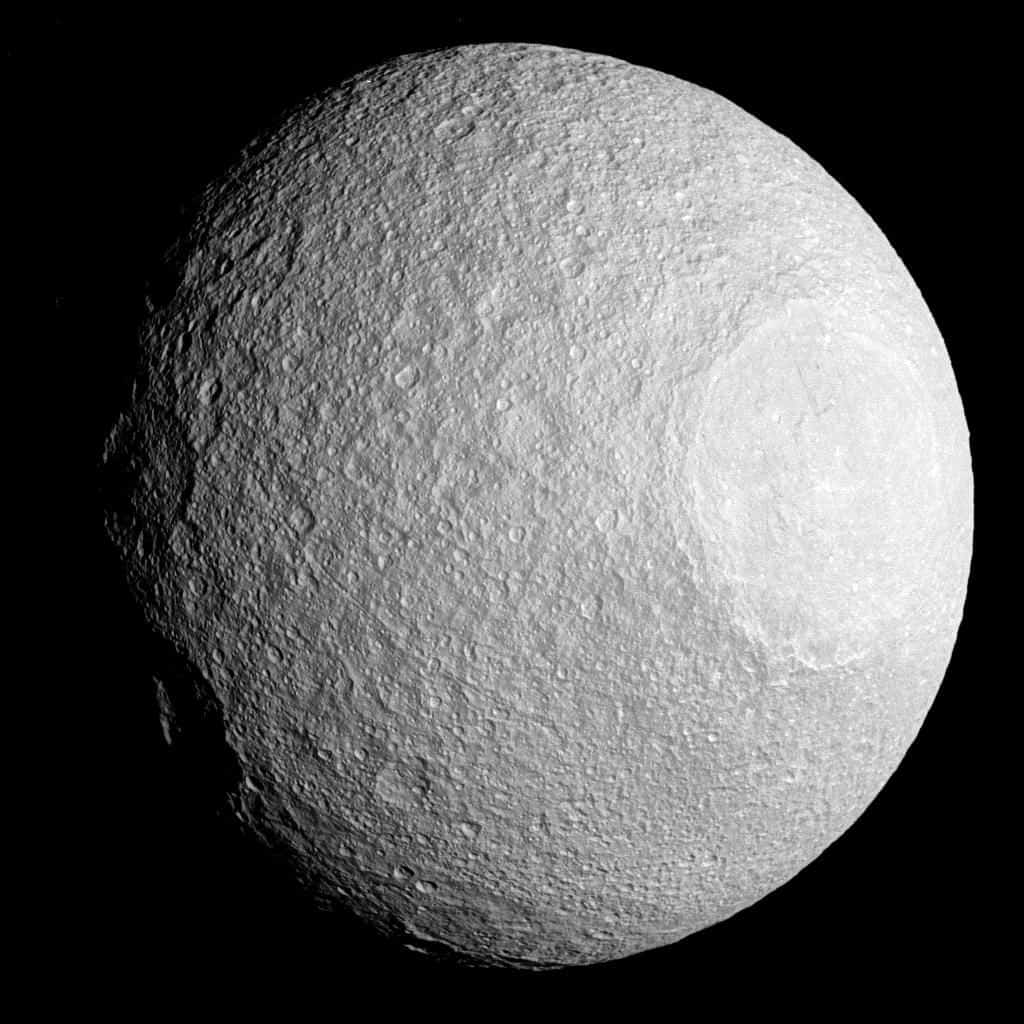
It has a diam of about 1.060 km / 660 Admiralty mile and a low denseness of 0.98 g/centimeter3. A small sum of money of anonymous black material is present on the moon. It is the second-brightest moon of Saturn and IT is heavily cratered and abridged by large faults/graben. A famous crater is named Odysseus, having a diam of 400 km / 248 mi. IT is believed that the moon scaphoid aboard the other regular moons from the Saturnian hero-nebula – a disk of gas and dust that surrounded Saturn soon after its formation. IT orbits Saturn at a distance of almost 295.000 km / 183.304 mi.
Dione
Dione is the second-largest inner moon of Saturn. It has a higher concentration than the geologically dead Rhea, the largest inner moon, but lower than that of active Enceladus.
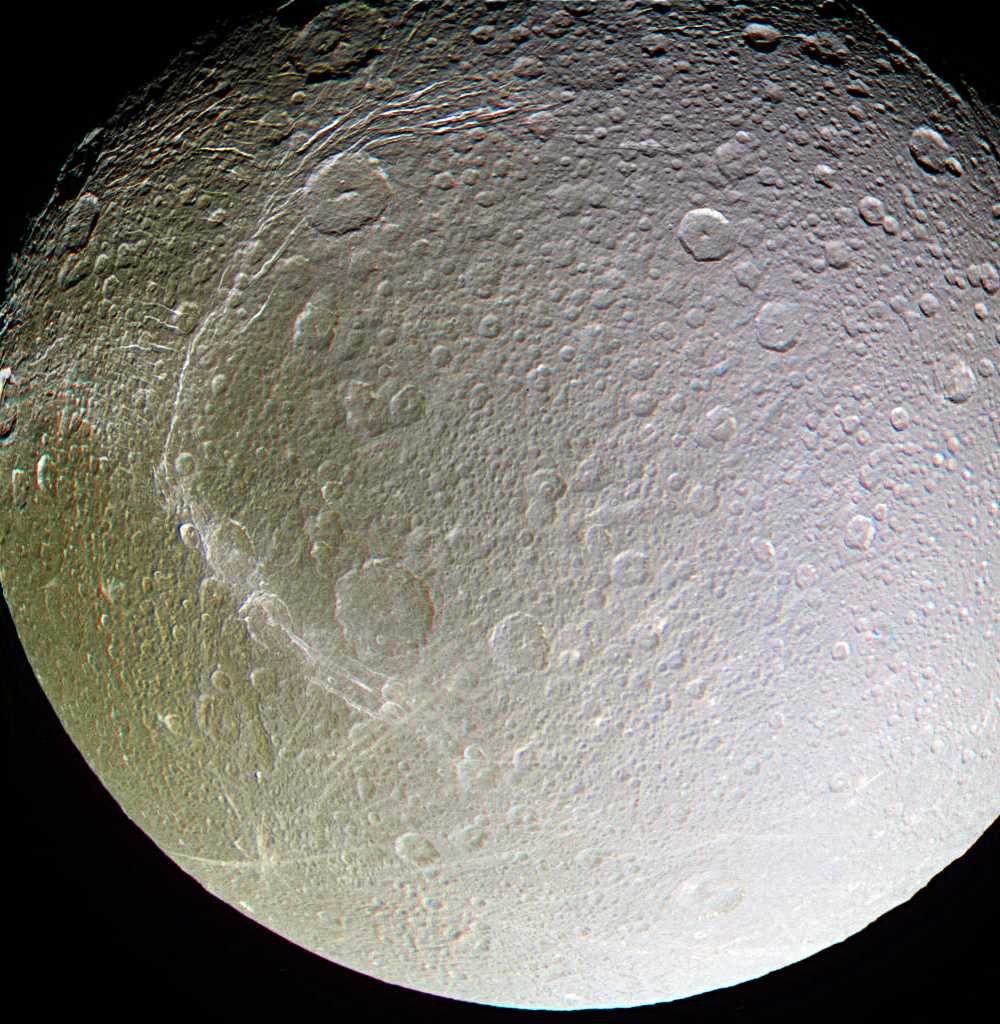
It was discovered in 1684 aside G.D. Cassini and named afterward a titan of Balkan nation mythology. It orbits Saturn with a semimajor Axis and it is currently in a 1:2 mean-motion route reverberance with moon on Enceladus, completing one orbit of Saturn for all two orbits completed by Enceladus.
This resonance maintains Enceladus's orbital eccentricity (0.0047), providing a source of heat for Enceladus's extensive geological activity, which shows up most dramatically in its cryovolcanic geyser-similar blue jets. Dione has a diameter of all but 1.122 km / 697 mi, existence the 15th largest lunar month in the Solar System while its mass is greater than whol the early small moons combined.
Just about two-thirds of Dione's great deal is water ice, and the remaining is a obtuse core, probably silicate careen. Further information suggests that it also has an internal liquid brine sea like to Enceladus.
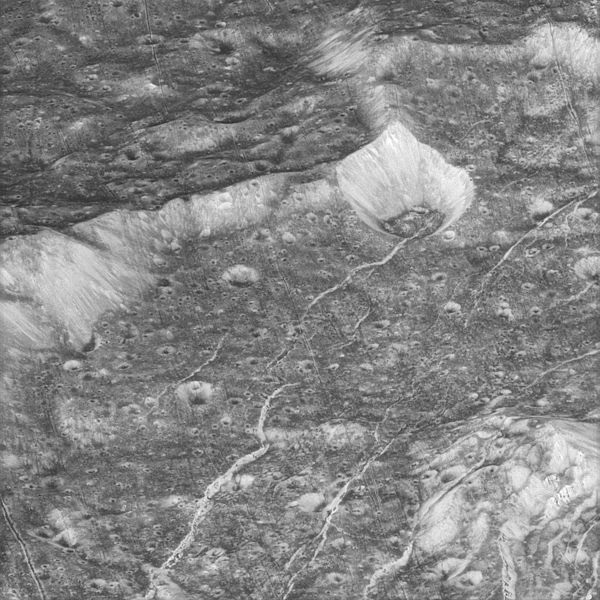
While the majority of Dione's surface is heavily cratered old terrain, the moon is as wel covered with an extensive network of troughs and lineaments, indicating that in the preceding it had global tectonic body process. Dione may be geologically active even now, although along a scale much little than the cryovolcanism of Enceladus.
Rhea
Named after the "sire of the gods" in Greek mythology, Rhea was observed in 1672 by G.D Cassini. It is the minute-largest moon of Saturn and the ninth-largest in the Solar System.
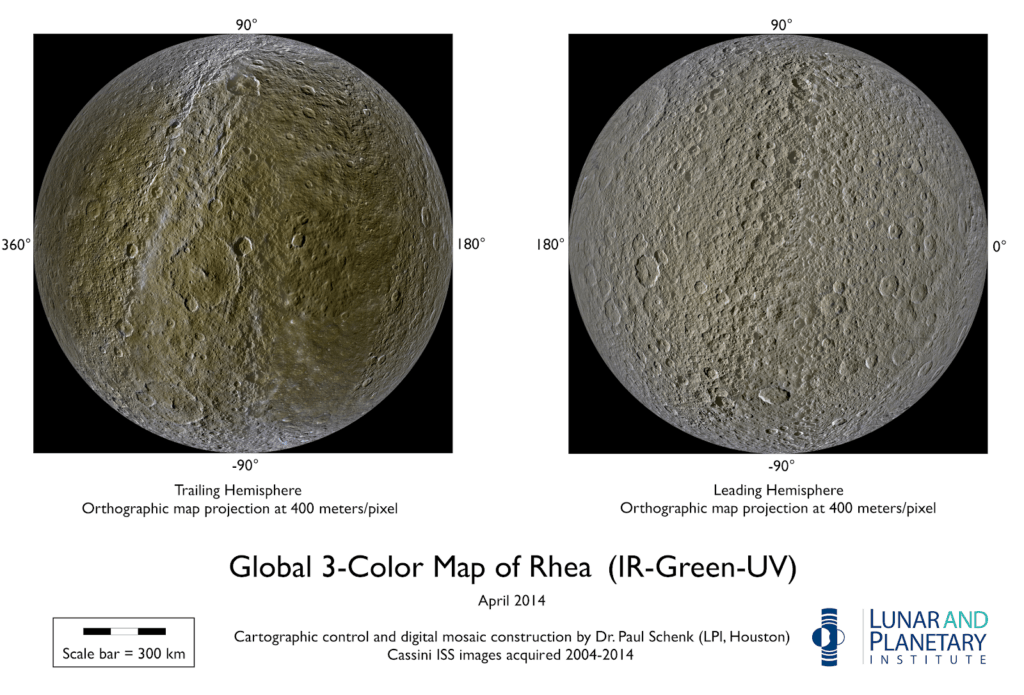
IT has a density of about 1.236 g/cm3. This abject density indicates that it is made of ~25% rock (denseness ~3.25 g/cm3) and ~75% ice (denseness ~0.93 g/cm3). Although Rhea is the ninth-largest Moon, IT is only the tenth-most-big moon. Nandu's features resemble those of Dione, with dissimilar leading and trailing hemispheres, suggesting confusable composition and histories. The temperature happening Rhea is 99 K (−174 °C) in related sunlight and between 73 K (−200 °C) and 53 K (−220 °C) in the shade.
Nandu has a diam of some 1.528 km / 949 mi and a tenuous atmosphere – exosphere - that consists of atomic number 8 and carbon dioxide. It is possible that Rhea may have a tenuous call system American Samoa cured, meaning IT would be the first Moon with rings ever discovered but observations cover.
Iapetus
The tertiary-largest moon of Saturn, Iapetus orbits its planet parent at a aloofness of 3.5 million km / 2.1 jillio international nautical mile, away far the most distant of Saturn's humongous moons, and as wel IT has the largest orbital inclination, 15.47°.
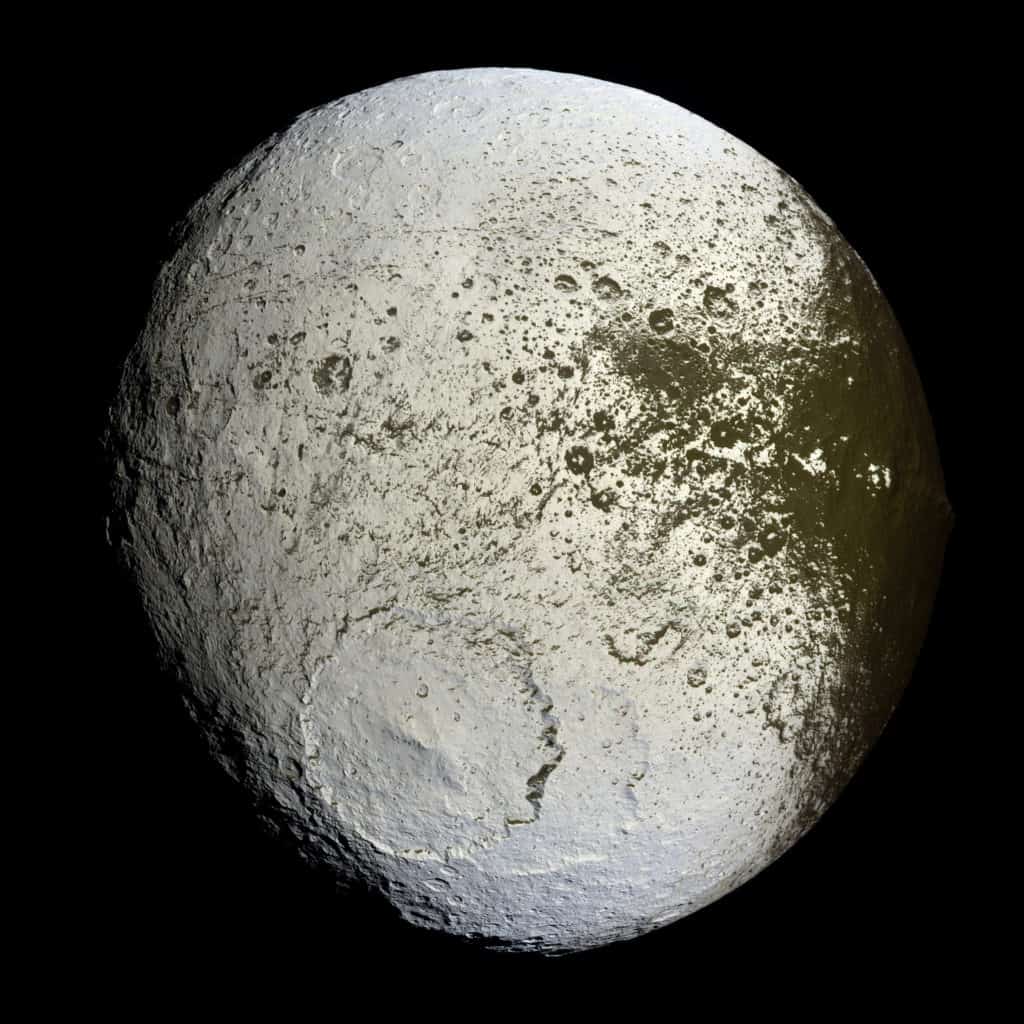
Known for its unusual cardinal-toned surface, it was discovered in 1671 by G.D. Cassini and named afterwards a titan of Greek mythology. It is tidally locked, always keeping the same face towards Saturn and has a diameter of about 1.436 kilometer / 892 mi. Due to its appearance, it is nicknamed the yin-yang of the solar scheme.
It also has a low density, indicating that IT is mostly comprised of ice and stony materials. Information technology's neither circular nor ellipsoid but has a biconvex waistline and squashed poles. This single great circle ridge is so high that it can be viewed from a outdistance. The equatorial ridge runs on the center of Cassini Regio, about 1,300 km (810 mi) long, 20 km (12 mi) wide, and 13 km (8.1 mi) high.
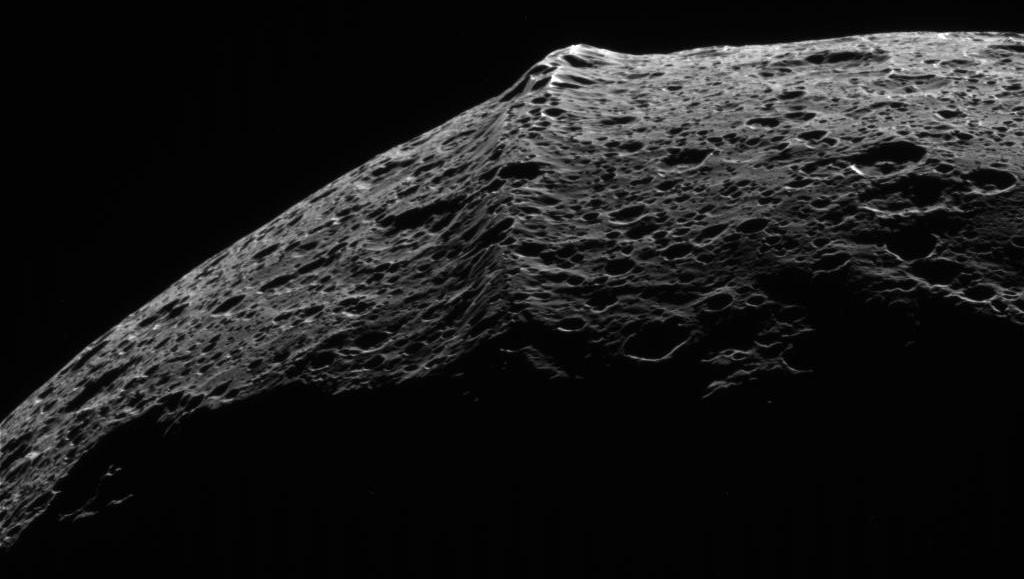
It is not well understood neither how this ridge was created nor wherefore Iapetus has such a disorganized orbit, but generally, IT is believed that collisions are at fault. The ii-tone coloration is often attributed to Phoebe, a small Moon that orbits Saturn. Phoebe is same dark and emits streams of particles referable the Sun's radiation and minor collisions.
These particles amass on one side of Iapetus piece the other remains white due to differences in temperature.
Planetary Rings
The moons of Saturn as wel play a use in the planet's ring scheme. The ring system of Saturn is the largest and most Gordian in the entire Solar System of rules. They are made out of ice and rock remnants from comets, asteroids, and moons.
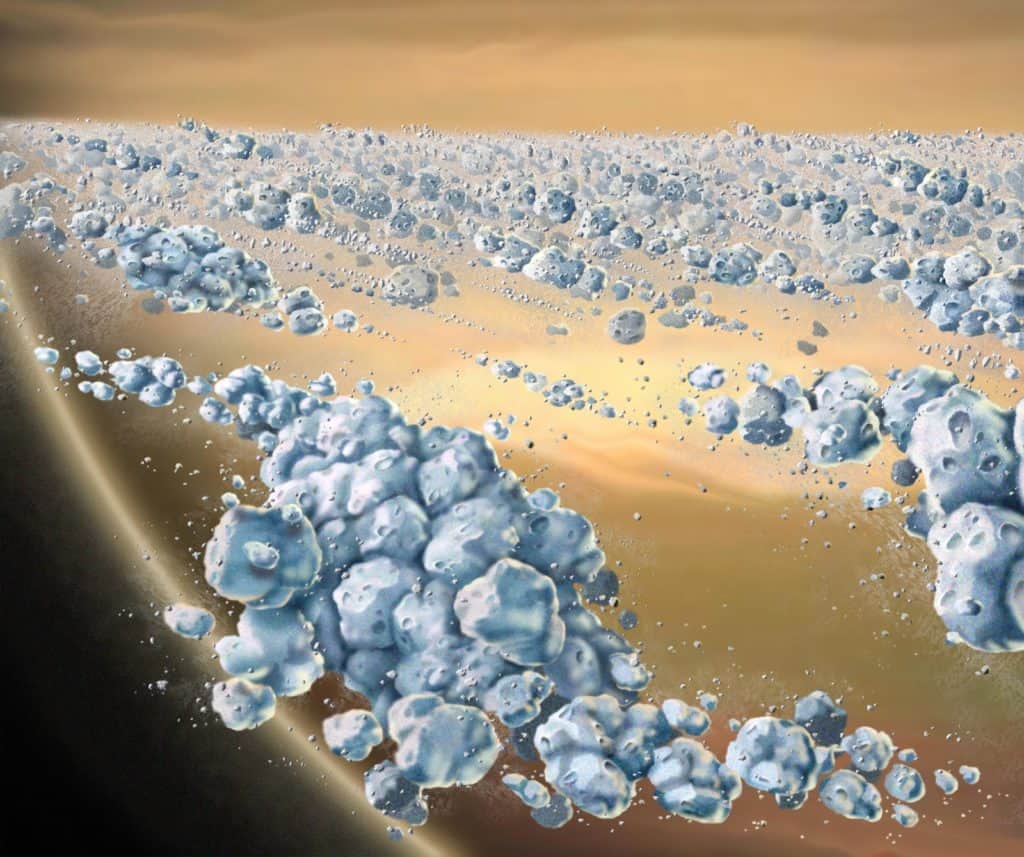
These particles range in sized from being as small as dust to American Samoa big as houses, or even mountains. The encircle arrangement is torn into 7 groups of rings: D Ring, C Phone, B Pack, A Phone, F Ring, G Ring, and E Mob.
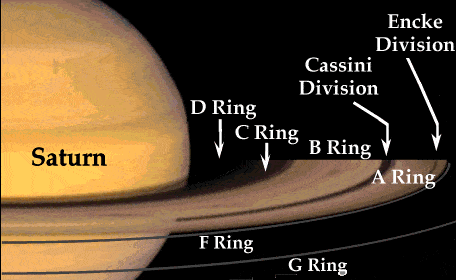
Together, they are arsenic wide atomic number 3 4.5 Earths but single about two-thirds of a nautical mile heavyset. The rings toilet continue up to 282.000 km / 175.000 mi from the planet. They quell intact and on track because of Saturn's smallest moons. These shepherding moons orbit 'tween the rings and use their gravitation to shape the ring material into circular paths.
Aliveness Habitability
Since it doesn't have a true surface, simply rather swirling fluids, it is not conducive to life as we have sex it. The moons of Saturn however, severally Titan and Enceladus, own internal oceans that could possibly hold life.
Future day plans for Saturn
Much of Saturn has been discovered, and much still remains to personify discovered. Right nowadays, since its moons, Titan and Enceladus, have higher chances of either containing life story or being middling more hospitable than Saturn and the rest of its moons, most our aid is directed towards them. The conditions on Heavyweight could turn far to a greater extent habitable in the out-of-the-way prox, intrinsically a mission named Dragonfly will launch in 2026, consisting of a large radio-controlled aircraft powered aside an RTG, to fly in the atmosphere of Titan.
The use of this mission is to study how far prebiotic chemistry may ingest progressed. IT is possible that Enceladus may also be subject to further observations.
Did you know?
- Saturn has the eeriest radio emissions in the Solar System of rules. The planet's sounds can personify set up and listened to, connected the internet.
- IT is estimated that Saturn leave lose its rings in about 100 million years. The rings are being pulled into Saturn aside gravity every bit a unclean rain of crank particles subordinate the influence of Saturn's magnetic field. This event is often called Ring Rain.
- The closest length of Saturn to Earth leave hap in 2091, at a distance of 8.03 AU.
- You could fit 764 Earths in spite of appearanc Saturn, and almost 1.600 Saturn's could appropriate into the Sun.
- A theory suggests that Saturn and Jupiter came close to one another and thus provoked the "Great Overflow" on Earth.
- Controversially, recent studies of ancient cultures show that the ancients might have erroneously considered Saturn as the Sun or at the least, a Sun-similar aim. Some cultures considered that Saturn was a star.
- The day Saturday was named after Saturn.
- The winds connected Saturn are the second fastest among the Star System's planets, after Neptune's.
- The mean apparent magnitude of Saturn is 0.46 with a criterional deviation of 0.34. Most of the order of magnitude variation is payable to the inclination of the ring system relational to the Sun and Earth. The brightest magnitude, −0.55, occurs near in time to when the plane of the rings is inclined about highly, and the faintest magnitude, 1.17, occurs around the fourth dimension when they are least disposed.
- Twice every Saturnian year - roughly every 15 Earth years - the rings of Saturn briefly disappear from opinion, owing to the way in which they are angled and because they are thin. Such an event will succeeding occur in 2025, but Saturn will be too close to the Sun for some ring-crossing observation to be practical.
- As Saturn is now the new king of the moons, with 20 new moons organism observed, a contend is held online for the naming of these moons. The contest ends on December 6, 2022 – so we recommend you to explore for this on the internet if you are interested in providing a name.
- Saturn's largest moon Titan comprises more than 96% of the raft in orbit around the major planet.
- Scientists surmise that the aura of early Earth was corresponding in opus to the prevailing air on Titan, with the decisive exception of a lack of water vapor on Titan.
- In Ancient Greek, Saturn was titled Phainon while in Hindu astrology, it was known every bit Shani, a god that judges everyone based on the good and bad deeds performed in life.
- Ancient Chinese and Japanese cultures designated Saturn as the "earth wizard".
- Almost two lashing of Saturn's mass came from Earth – The Cassini spacecraft was intentionally vaporized in Saturn's atmosphere in 2022.
- Entirely four spacecraft's have visited Saturn: NASA'S Pioneer 11 in 1979, NASA'S twin Voyager 1 &ere; 2 in 1980 and 1981, and the international Cassini spacecraft deputation in 2004.
- The spacecraft Cassini studied Saturn for well-nig 13 years.
Sources:
- National Aeronautics and Space Administration
- Wikipedia
Image source:
- https://upload.wikimedia.org/wikipedia/commons/c/c7/Saturn_during_Equinox.jpg
- https://www.universetoday.com/24161/saturn-compared-to-world/
- https://scitechdaily.com/chiron-may-possess-saturn-like-rings/
- https://upload.wikimedia.org/wikipedia/commons/2/2d/Saturn_diagram.svg
- https://upload.wikimedia.org/wikipedia/commons/2/29/Saturn_Storm.jpg
- https://upload.wikimedia.org/wikipedia/commons/b/bd/Rotatingsaturnhexagon.gif
- https://upload.wikimedia.org/wikipedia/park/5/57/Looking_saturn_in_the_eye.jpg
- https://upload.wikimedia.org/wikipedia/commons/b/b1/Saturn%27s_double_aurorae_%28captured_by_the_Hubble_Space_Telescope%29.jpg
- https://upload.wikimedia.org/wikipedia/commons/f/f7/Saturn%27s_Rings_PIA03550.jpg
- https://carnegiescience.edu/NameSaturnsMoons
- https://upload.wikimedia.org/wikipedia/green/4/4b/Moons_of_Saturn_2007.jpg
- https://upload.wikimedia.org/wikipedia/commons/4/45/Titan_in_true_color.jpg
- https://upload.wikimedia.org/wikipedia/commons/b/b4/Titan%2C_Earth_%26_Moon_size_comparison.jpg
- https://upload.wikimedia.org/wikipedia/commons/d/da/Vortex_on_saturn%27s_moon_titan.png
- https://upload.wikimedia.org/wikipedia/commons/9/94/Hyperion_true.jpg
- https://upload.wikimedia.org/wikipedia/commons/8/83/PIA17202_-_Approaching_Enceladus.jpg
- https://upload.wikimedia.org/wikipedia/commons/7/72/PIA19061-SaturnMoonEnceladus-CurtainNotDiscrete-Eruptions-20150506.jpg
- https://upload.wikimedia.org/wikipedia/commonality/b/bc/PIA18317-SaturnMoon-Tethys-Cassini-20150411.jpg
- https://upload.wikimedia.org/wikipedia/commons/c/c7/Dione_color.jpg
- https://en.wikipedia.org/wiki/File cabinet:Dione_PIA07748_-Amastrus_grooves.jpg
- https://upload.wikimedia.org/wikipedia/commons/f/f5/PIA18438-SaturnMoon-Rhea-20141104-fig2.jpg
- https://upload.wikimedia.org/wikipedia/commons/c/c9/Iapetus_as_seen_by_the_Cassini_probe_-_20071008.jpg
- https://upload.wikimedia.org/wikipedia/commons/b/b4/Iapetus_equatorial_ridge.jpg
- https://upload.wikimedia.org/wikipedia/commons/d/de/Saturn_Ring_Material.jpghttp://www.solstation.com/stars/sat1ring.gif
2006 Saturn Vue Cooling Fan Kicks on at What Temperature
Source: https://nineplanets.org/saturn/

0 Komentar
Post a Comment